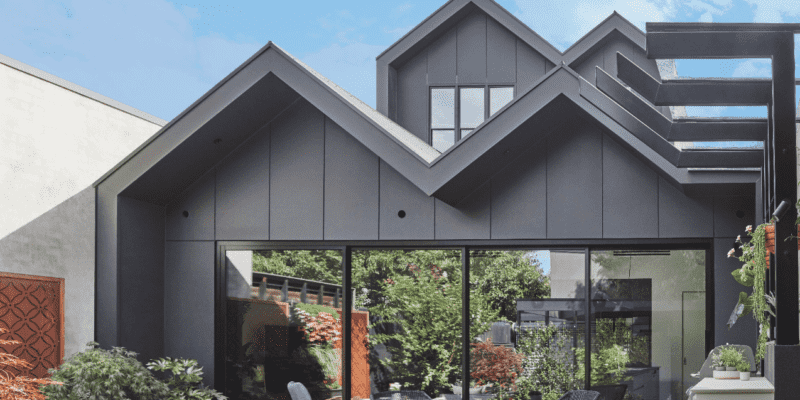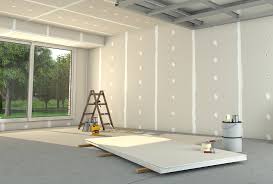As a homeowner or contractor, it’s important to understand the differences between cement sheet and plasterboard when considering a building or renovation project.
These two materials vary in terms of durability, installation process, price, and other factors.
This article will explain the basic material properties, evaluate their longevity and durability, compare installation processes and prices, as well as discuss how to tailor your choice of material to specific project needs.
With this information you’ll be able to make an informed decision about which material is best for your particular project.
Key Takeaways
- Fiber cement board is a composite material made of fibre cement reinforced with cellulose fibers, while gypsum board is a panel made off friable gypsum powder core pressed between two sheets of paper.
- Fiber cement board is more durable and impact-resistant than gypsum board, making it suitable for exterior applications and areas that require increased strength.
- Gypsum board (Gyprock) is lighter and cheaper than fiber cement board, and it provides a smoother surface and nicer touch on the edge joints between the boards.
- Fiber cement board can be water-resistant or waterproof, making it suitable for wet areas like bathrooms and kitchens, while gypsum board is only water-resistant and not suitable for wet applications or as tiling adhere boards.
Understanding Basic Material Properties
When considering the differences between cement sheet and plasterboard, it’s important to understand their basic material properties. This includes water resistance, strength, and purpose, which will help you make an informed decision.
Cement sheet is made of cement reinforced with cellulose fibers, while gypsum board is a panel of gypsum plaster pressed between two thick sheets of paper. Both materials have different levels of moisture resistance. Cement sheet is more water-resistant than gypsum board, making it suitable for wet areas like bathrooms and kitchens where there is a risk of mold or mildew. On the other hand, gypsum board can be easily damaged if not handled with care.
In terms of weight and handling, fiber cement board tends to be heavier than its counterpart due to its composite material. This makes installation more difficult but also adds extra strength when installed correctly. Gypsum board, on the other hand, is lighter weight and requires less effort in terms of handling but lacks in strength when compared to fiber cement boards.
When it comes to aesthetics and finishing options, both materials offer different advantages. Fiber cement boards provide a rougher texture than that provided by gypsum boards, giving them an edge for certain design applications. On the other hand, gypsum boards offer a smoother surface, providing a nicer touch on the edge joints between the boards. Also, both materials accept paint or primer, allowing for further customization depending on the desired look.
Considering all these factors carefully will ensure you get the best material for your application needs, whether you choose fiber cement or gypsum board. Paying attention to detail from material composition up until aesthetics will help you determine which option works best for your project.
Evaluating Durability and Longevity
You must decide between two materials for your project – fiber cement board and gypsum board – that have different levels of durability and longevity. Fiber cement board is more resistant to moisture, impact, and fire than gypsum board. It also requires minimal maintenance compared to its counterpart as it’s made from a composite material reinforced with cellulose fibers and often waterproof or water-resistant. Fiber cement also provides better environmental sustainability due to its resistance against UV rays, strong winds, rain, and other weather conditions.
On the other hand, although gypsum board is lightweight and easier to install with a utility knife than fiber cement boards, which require a circular saw with a heavy-duty blade for cutting, it doesn’t have the same level of resistance against moisture or fire. It shouldn’t be used in wet areas such as bathrooms or kitchens since it’s only water-resistant but not waterproof. In addition, plasterboard liner needs to be applied on both sides of the panel for increased strength and durability.
Therefore, when evaluating durability and longevity of materials, you must consider their respective properties such as resistance to moisture, impact resistance, resistance to fire along with their maintenance requirements and environmental sustainability before making your choice.
Installation Process and Complexity
Installing fiber cement board is more complex than gypsum board, as it requires a circular saw with a heavy-duty blade for cutting and needs to be secured with decking screens or roofing nails. These installation techniques require additional time and effort compared to the ease of cutting gypsum board with a utility knife.
Moisture resistance is another factor that should be considered when deciding between the two boards. Fiber cement board can be water-resistant or waterproof, making it suitable for areas where moisture levels may fluctuate.
Additionally, weight considerations must also be taken into account. While both are relatively lightweight, fiber cement board is heavier than gypsum board and may require additional support for larger installations.
In terms of finishing options, both boards accept paint and primer but gypsum board has a smoother surface which provides a nice touch on the edge joints between the boards. Fiber cement board has rough sides which can be overlayed with textiles or plastered directly onto interior walls or ceilings.
Overall, when it comes to installation process and complexity, fiber cement has several advantages over traditional drywall due to its increased durability and moisture resistance properties. However, these advantages come at the cost of added time and effort in terms of installation techniques as well as weight considerations during construction.
Also see our article on how to use a stud finder on plasterboard walls.
Price Comparison
When it comes to price, gypsum board is a more affordable option than fiber cement board. Cost difference depends on the type and quantity of material purchased. Budget considerations should include installation costs and future maintenance, which may be higher for fiber cement boards. Below is a price comparison at the time of writing:
- Plasterboard current price (1200 x 10mm) – $22.21 at Bunnings
- Cement Sheet current price (1200 x 6mm) – $31.56 at Bunnings
Tailoring to Specific Project Needs
No matter the project, it’s important to consider both fiber cement board and gypsum board to determine which is best suited for your particular needs. Installation techniques are a major factor in choosing either board, as each has its own unique requirements.
Fiber cement boards require heavy-duty cutting tools like circular saws with a heavy-duty blade while gypsum boards only need a utility knife. Maintenance requirements also differ between the two materials; fiber cement boards require decking screens or roofing nails to stay in place, while gypsum boards can be secured with taper-head drywall screws.
Aesthetic considerations should also be taken into account when selecting either type of board. While both types accept paint and primer, fiber cement board has a rougher surface (but a smoother surface on one side) that may provide an interesting touch on the edge joints between boards whereas gypsum boards have smoother sides for a cleaner look. However, cement sheets can certainly finish very well if prepared correctly and attention to detail is take for painting and finishing.
The environmental impact of using one material over another should also be considered. Fiber cement board is more durable than gypsum and can withstand long exposure to UV rays and harsh weather conditions such as strong winds and rain, making it better for exterior applications or in your workshop or shed. Acoustic properties are yet another way the two materials differ; due to its greater thickness, fiber cement board provides better noise reduction compared to drywall.
Conclusion
Comparing cement sheet and plasterboard, it’s clear that each has its own unique benefits. Fiber cement board is more durable and impact-resistant, waterproof and water-resistant, making it a better choice for exterior applications.
Gypsum board is not suitable for wet areas, but its low cost makes it a great option for interior walls and ceilings. Ultimately, the right material will depend on your project needs and budget constraints.
The important thing is to weigh all factors carefully before making a decision.


